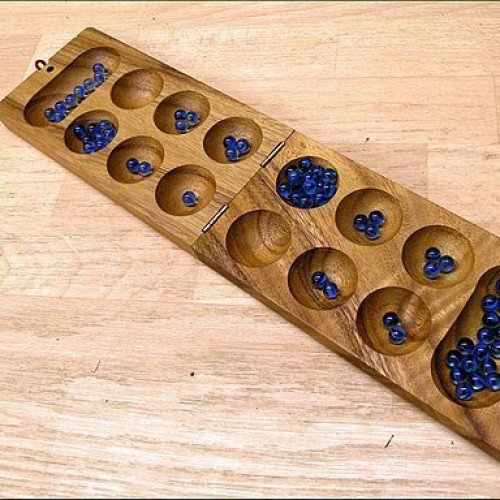A GAME OF WAR VS KALAH

A GAME OF WAR
A Game of War is a book by Guy Debord and Alice Becker-Ho that illustrates a game devised by Debord by giving a detailed account of one of their table-top conflicts. It was first published in French as Le Jeu de la Guerre in 1987, but unsold copies were later pulped in 1991, along with other books by Debord, at his insistence when he left his publisher Champ libre. The book was reissued in 2006, with an English translation published by Atlas Press in 2008. In his 1989 book Panegyric, Guy Debord remarked: So I have studied the logic of war. Indeed I succeeded long ago in representing its essential movements on a rather simple game-board… I played this game, and in the often difficult conduct of my life drew a few lessons from it — setting rules for my life, and abiding by them. The surprises vouchsafed by this Kriegspiel of mine seem endless; I rather fear it may turn out to be the only one of my works to which people will venture to accord any value. As to whether I have made good use of its lessons, I shall leave that for others to judge. Apart from the books which contain the game, free online versions of the game are available. London based group, Class Wargames have reproduced A Game of War and taken it on a campaign around the globe, at Belo Horizonte, pictured above, St. Petersburg and a variety of other locations.
Statistics for this Xoptio

KALAH
Kalah, also called Kalaha or Mancala, is a game in the mancala family invented in the United States by William Julius Champion, Jr. in 1940. This game is sometimes also called "Kalahari", possibly by false etymology from the Kalahari desert in Namibia. As the most popular and commercially available variant of mancala in the West, Kalah is also sometimes referred to as Warri or Awari, although those names more properly refer to the game Oware. For most of its variations, Kalah is a solved game with a first-player win if both players play perfect games. The Pie rule can be used to balance the first-player's advantage. Mark Rawlings has written a computer program to extensively analyze both the "standard" version of Kalah and the "empty capture" version, which is the primary variant. The analysis was made possible by the creation of the largest endgame databases ever made for Kalah. They include the perfect play result of all 38,902,940,896 positions with 34 or fewer seeds. In 2015, for the first time ever, each of the initial moves for the standard version of Kalah(6,4) and Kalah(6,5) have been quantified: Kalah(6,4) is a proven win by 8 for the first player and Kalah(6,5) is a proven win by 10 for the first player. In addition, Kalah(6,6) with the standard rules has been proven to be at least a win by 4. Further analysis of Kalah(6,6) with the standard rules is ongoing. For the "empty capture" version, Geoffrey Irving and Jeroen Donkers (2000) proved that Kalah(6,4) is a win by 10 for the first player with perfect play, and Kalah(6,5) is a win by 12 for the first player with perfect play. Anders Carstensen (2011) proved that Kalah(6,6) was a win for the first player. Mark Rawlings (2015) has extended these "empty capture" results by fully quantifying the initial moves for Kalah(6,4), Kalah(6,5), and Kalah(6,6). With searches totaling 106 days and over 55 trillion nodes, he has proven that Kalah(6,6) is a win by 2 for the first player with perfect play. This was a surprising result, given that the "4-seed" and "5-seed" variations are wins by 10 and 12, respectively. Kalah(6,6) is extremely deep and complex when compared to the 4-seed and 5-seed variations, which can now be solved in a fraction of a second and less than a minute, respectively.